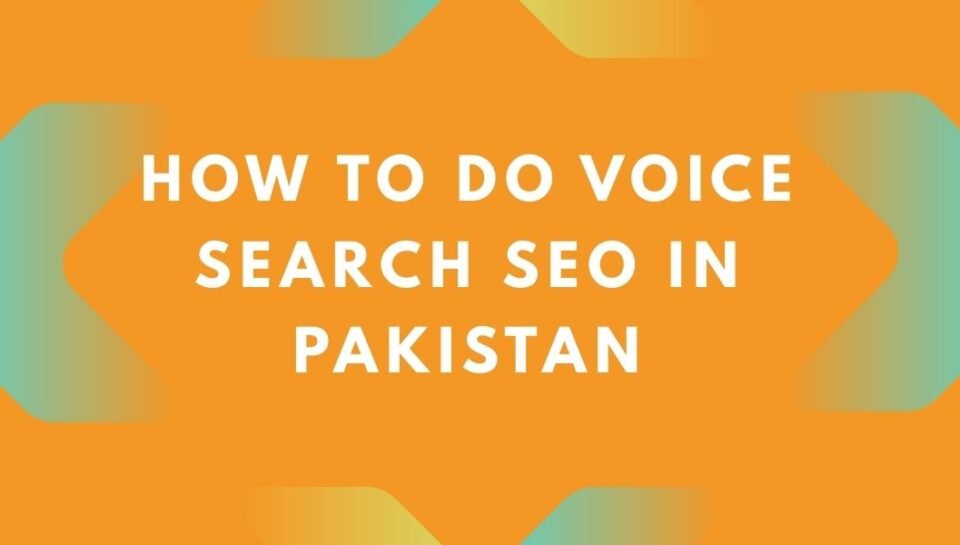
Voice search is changing how people find information online—especially in Pakistan, where mobile-first usage, multilingual audiences, and “near me” micro-moments are the norm. Whether users say “best biryani near me,” “Lahore plumber open now,” or ask in Urdu, Roman Urdu, or English, businesses that optimize for voice search can capture high-intent traffic and ready-to-convert customers.
Why Voice Search Matters in Pakistan
- Mobile-first reality: A significant share of internet activity in Pakistan happens on smartphones, where voice input is fast, hands-free, and convenient.
- Multilingual habits: Users mix Urdu, Roman Urdu, and English in real conversations—and do the same with voice queries.
- Local intent: “Near me,” “open now,” and “price” questions dominate commercial voice searches in urban centers like Karachi, Lahore, Islamabad, and beyond.
- Assistant ecosystem: Google Assistant on Android is widely used and tightly integrated with Google Search, Maps, and YouTube—key surfaces for discovery.
Bottom line: Voice search SEO in Pakistan is about understanding conversational intent, serving multilingual audiences, and making your content easily discoverable and speakable.
What Makes Voice Search Different in Pakistan
Conversational, natural questions
Voice queries sound like how people talk. Instead of typing “dentist Lahore,” a user says, “Who is the best dentist in Lahore for root canal?” or “Lahore dentist near me open now.”
Language mixing (Urdu, Roman Urdu, English)
Code-switching is common: “Karachi ka best steakhouse near me,” or “passport office timings Islamabad.” Capture these with content and metadata that reflect mixed-language patterns.
Local, micro-moment searches
- Transactional: “Order pizza in Gulshan Block 5,” “book cab to airport.”
- Informational: “How to renew CNIC,” “petrol price today Pakistan.”
- Navigational: “Directions to Emporium Mall.”
Assistants and surfaces
- Google Assistant: The primary channel on Android, powered by Google Search and Maps.
- Siri: Strong among iPhone users; data still comes from Apple Maps and web sources.
- Alexa and smart speakers: Emerging, more common in English; good for certain skills and content types.
Keyword Research for Voice Search in Pakistan
Focus on long-tail, question-based, and local-intent terms that mirror speech. Combine English, Urdu, and Roman Urdu variations where relevant.
How to build your voice keyword set
- Mine real queries: Use Google Search Console to pull queries with “who,” “what,” “where,” “when,” “how,” “near me,” “open now,” “price,” “cost,” “kese/kaise,” “kidhar,” “qareeb,” and location names (e.g., “DHA Phase 5”).
- Expand with question tools: AlsoAsked, People Also Ask panels, and “Related searches” give you natural-language questions to answer directly.
- Localize by dialect and transliteration: Include “qareeb,” “kareeb,” “nearby,” and Roman Urdu variants like “karachi mein best dentist,” “lahore me nashta near me.”
- Cluster by intent: Group keywords into informational (how-to), transactional (buy/book/order), and local (near me/open now) clusters for targeted pages/sections.
Example keyword clusters (Dentist in Lahore)
- Local/Commercial: “best dentist in Lahore near me,” “root canal specialist DHA Lahore,” “dentist open now Lahore Gulberg.”
- Informational: “how much does root canal cost in Lahore,” “braces price in Pakistan,” “how to reduce tooth pain at night.”
- Roman Urdu: “lahore me best dentist,” “root canal ki price kya hai,” “bachon ka dentist gulberg.”
Pro tip: Map each cluster to a page or robust section with clear, concise answers that can win featured snippets and voice responses.
Create Voice-Friendly Content
Write the way people speak
- Use short, clear sentences and natural phrasing.
- Answer one question per paragraph in 40–60 words where possible—perfect for featured snippets.
- Include synonyms: “price,” “cost,” “fees,” “charges.”
Build FAQ hubs and Q&A snippets
Create FAQ sections on service pages and a central FAQ hub. Mark them up with FAQPage schema to improve eligibility for rich results and voice answers.
Example Q&A blocks
Q: What is the best halwa puri in Lahore near me?
A: The best halwa puri spots in Lahore’s Gulberg and DHA include XYZ and ABC. They open at 7 AM on weekends and offer takeaway. For live directions, check Google Maps and look for places with 4.5+ star ratings and recent reviews.
Q: Root canal price in Pakistan?
A: Root canal prices in Pakistan typically range by city and clinic expertise. In major cities, expect mid-range to premium pricing; call clinics for exact quotes and ask if the crown is included.
Multilingual and Roman Urdu strategy
- Offer key content in English and Urdu, and acknowledge Roman Urdu phrases naturally in headings or FAQs when they reflect real search behavior.
- Use Urdu or Roman Urdu for common local questions (e.g., “passport renewal ka tareeqa”). Provide a clear, helpful answer in the same section.
- Ensure readability on mobile with clear typography and spacing.
In our work with local brands, we’ve seen that blending conversational English with localized Roman Urdu phrases in headings and FAQs increases impressions for voice-like queries and “near me” searches. This approach is used by experienced teams such as NB Disruptors to align with how Pakistanis actually speak to their phones.
Local SEO Essentials for Voice
Optimize your Google Business Profile (GBP)
- Exact business name, primary category, secondary categories, and precise address and map pin.
- Accurate hours, holiday hours, phone number (click-to-call), website, and appointment links.
- Services and products filled in with keyword-rich but natural descriptions (e.g., “Emergency plumber in Lahore – 24/7”).
- Photos and short videos of location, staff, and products.
- Regular Posts for offers, events, and updates.
- Q&A: Seed top questions and answer them clearly to feed voice responses.
NAP and citations
Keep your Name, Address, and Phone consistent across your website, social profiles, and credible local directories. Consistency strengthens local trust signals used by voice assistants.
Reviews and reputation
- Request reviews that mention services and locations naturally (e.g., “AC repair in Johar Town”).
- Respond to every review promptly and professionally.
- Use review insights to create new FAQ content.
Technical Optimization for Voice
Speed and Core Web Vitals
- Target excellent scores for Largest Contentful Paint (LCP), Cumulative Layout Shift (CLS), and Interaction to Next Paint (INP).
- Compress images (WebP/AVIF), lazy-load below-the-fold media, and use efficient caching and a CDN with a nearby POP.
- Minimize JavaScript and third-party scripts that delay rendering.
Structured data (schema.org)
Add JSON-LD markup to help search engines understand your content and increase eligibility for rich results, which often power voice answers.
- LocalBusiness / Organization
- FAQPage for Q&A sections
- HowTo for step-by-step guides (when visual steps are present)
- Product with offers and aggregateRating
{
"@context": "https://schema.org",
"@type": "LocalBusiness",
"name": "Example Dental Clinic Lahore",
"image": "https://example.com/clinic.jpg",
"address": {
"@type": "PostalAddress",
"streetAddress": "123 Main Blvd, Gulberg",
"addressLocality": "Lahore",
"addressRegion": "Punjab",
"postalCode": "54000",
"addressCountry": "PK"
},
"geo": {"@type": "GeoCoordinates","latitude": 31.5204,"longitude": 74.3587},
"url": "https://example.com",
"telephone": "+92-300-0000000",
"openingHours": "Mo-Su 09:00-21:00",
"sameAs": ["https://maps.google.com/?cid=XXXX","https://www.facebook.com/example"]
}Mobile UX that supports voice journeys
- Simple navigation, large tap targets, and sticky click-to-call buttons.
- Avoid intrusive pop-ups—especially on entry.
- Readable fonts and high-contrast color choices.
Speakable content considerations
Keep key answers concise and definitive. “Speakable” markup is limited (mainly for news), but the principle applies: short, clear, and structured answers are more likely to be read aloud.
Optimize for Urdu and Regional Languages
Script and transliteration
- Use Urdu in Arabic script for formal pages or guides relevant to government services or cultural topics.
- Reflect Roman Urdu where users search that way: “kareeb,” “qareeb,” “kesa/kaisa,” “qeemat/price.”
- Include common variations naturally in FAQs and headings to capture variant pronunciations and spellings.
Hreflang and language targeting
- Use hreflang for English (en-PK) and Urdu (ur-PK) versions to reduce duplication and show the right language per user.
- Set lang attributes on HTML elements (e.g., lang=”ur-PK” for Urdu pages).
- Keep URLs clean and predictable (e.g., /ur/ for Urdu sections).
Consider regional intent
Localize content to city and neighborhood names commonly used in voice queries: “F-7 Islamabad,” “PECHS Karachi,” “Bahria Town Lahore.”
Content Ideas That Perform Well in Voice Search (Pakistan)
- Restaurants: “Best karahi near me,” “iftaar buffet timings Karachi today,” “halal steakhouse DHA Lahore.”
- Home services: “AC service Johar Town open now,” “electrician emergency Islamabad.”
- Healthcare: “female gynecologist near me Lahore,” “clinic timings Eid holidays.”
- Education: “SAT prep Islamabad fee,” “admission last date Punjab University.”
- Travel: “train timings Lahore to Karachi,” “Murree weather this weekend,” “hotel near Mall Road.”
- Ecommerce: “best budget phone under 50k,” “cash on delivery Karachi.”
- Finance: “dollar rate today Pakistan,” “how to open Meezan Bank account online.”
- Public services: “how to renew driving license Lahore,” “passport office timings G-10.”
Measuring Voice Search SEO
What to track
- Search Console: Impressions and clicks for question keywords (“who, what, where, when, how”), “near me,” “open now,” and city names.
- Featured snippets and People Also Ask placements via SERP tracking tools.
- Google Business Profile: Calls, direction requests, website visits, and query insights.
- Call tracking and UTM-tagged CTA buttons for mobile.
- Core Web Vitals in PageSpeed Insights and GSC for performance progress.
Practical process
- Export GSC queries monthly; label voice-like patterns.
- Refresh FAQs and add new Q&As based on rising questions.
- Test pages in Lighthouse; fix slow templates first.
- Solicit reviews that mention services + locality naturally.
Common Mistakes to Avoid
- Writing only for short, head terms; ignoring question-based and long-tail keywords.
- Overlooking Urdu/Roman Urdu queries in cities where they dominate.
- Thin, generic FAQs with no structured data.
- Inconsistent NAP and poor GBP hygiene (wrong hours, missing categories).
- Slow mobile pages and heavy third-party scripts.
- Walls of text with no scannable answers; no “best answer” paragraphs.
Quick Voice SEO Checklist (Pakistan)
- Research question-based, local, and Roman Urdu variations.
- Group keywords by intent and city; map to dedicated pages/sections.
- Create concise answers (40–60 words) for top questions; add FAQs.
- Implement FAQPage, LocalBusiness, and relevant schema.
- Optimize Google Business Profile fully; monitor Q&A and reviews.
- Polish mobile UX; add click-to-call; minimize pop-ups.
- Improve Core Web Vitals; compress images; reduce JS.
- Localize content by neighborhood and landmarks.
- Offer Urdu and English; use hreflang; include Roman Urdu where relevant.
- Measure via GSC, GBP insights, and call tracking; iterate monthly.
Example Scenario: Voice Optimization for a Lahore Clinic
Situation: A dental clinic in Lahore ranks for “dentist Lahore” but gets few calls from mobile.
Actions:
- Keyword research expands to “root canal specialist DHA,” “braces price in Lahore,” “bachon ka dentist gulberg.”
- Service pages updated with 40–60 word answer boxes for top questions; an FAQ hub added with FAQPage schema.
- Google Business Profile categories refined; hours, services, and Q&A completed; new photos and weekly Posts added.
- Core Web Vitals improved by compressing images and deferring non-critical JS; click-to-call button made sticky on mobile.
- Reviews requested via WhatsApp follow-up; responses mention service and location naturally.
Expected outcomes over 8–12 weeks:
- More impressions for question and “near me” queries.
- Lift in featured snippets and People Also Ask appearances.
- Higher GBP calls and direction requests, especially evenings/weekends.
- Better mobile engagement (lower bounce, more call clicks).
Tip: Revisit your FAQs monthly to cover new questions showing in Search Console and GBP insights.
Conclusion
Voice search SEO in Pakistan is about meeting users where they are: on mobile, speaking naturally, and mixing languages. Brands that structure concise answers, localize content down to neighborhoods, and maintain stellar technical performance will win more “near me,” “open now,” and “price” moments. Start with conversational keyword research, build voice-friendly FAQs, optimize your Google Business Profile, and keep pages fast. Measure what matters, iterate often, and your visibility in voice-driven searches will compound over time.




